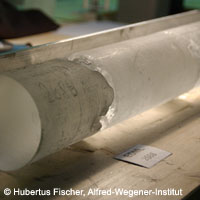European researchers uncover link between climate patterns in Arctic and Antarctic
Scientists working on the European Project for Ice Coring in the Antarctic (EPICA) have established a link between temperature changes in the Arctic and Antarctic by looking at air bubbles trapped in ice cores. The glacial climate in the north Atlantic is characterised by rapid temperature increases of 8 to 16°C followed by gradual cooling. In contrast temperature changes in the Antarctic region tend to be slower and smaller, in the region of 1 to 3°C. Now the EPICA team, which is made up of scientists from 10 European countries, has demonstrated how these temperature changes at opposite ends of the Earth are linked by changes in currents in the Atlantic Ocean. Their findings are published in the latest edition of the journal Nature. Key to the success of the team was the drilling of an ice core at Dronning Maud Land. The area has a very high snow accumulation rate, creating an ice core which allows for very high resolution atmospheric and climate records. The EPICA team was then able to synchronise the Dronning Maud Land ice core with ice cores from the North Greenland Ice Core Project (NGRIP). They found that temperature changes at the poles are related, even on quite short timescales. According to the researchers, these changes are the result of changes in oceanic currents in the Atlantic known as the deep meridional overturning circulation (MOC), which the scientists liken to a sea-saw effect. As the Antarctic warmed, the North was cold and the export of warm water from the southern ocean was reduced. In contrast, when warm water started to flow into the north Atlantic from the South, the Antarctic got cooler and the Arctic got warmer. 'It is really astounding how systematic this process worked also for smaller temperature changes in the Antarctic,' commented paleoclimatologist Dr Hubertus Fischer from the Alfred-Wegener Institute for Polar and Marine Research (AWI) in Bremerhaven and one of the authors of the study. 'Our data shows that the degree of warming in the South is linearly related to the duration of cold periods in the North Atlantic.' In the paper the researchers note that such research is important as understanding the relationship between climate changes in the two hemispheres is key to understanding the Earth's climate dynamics.
Countries
Antarctica

